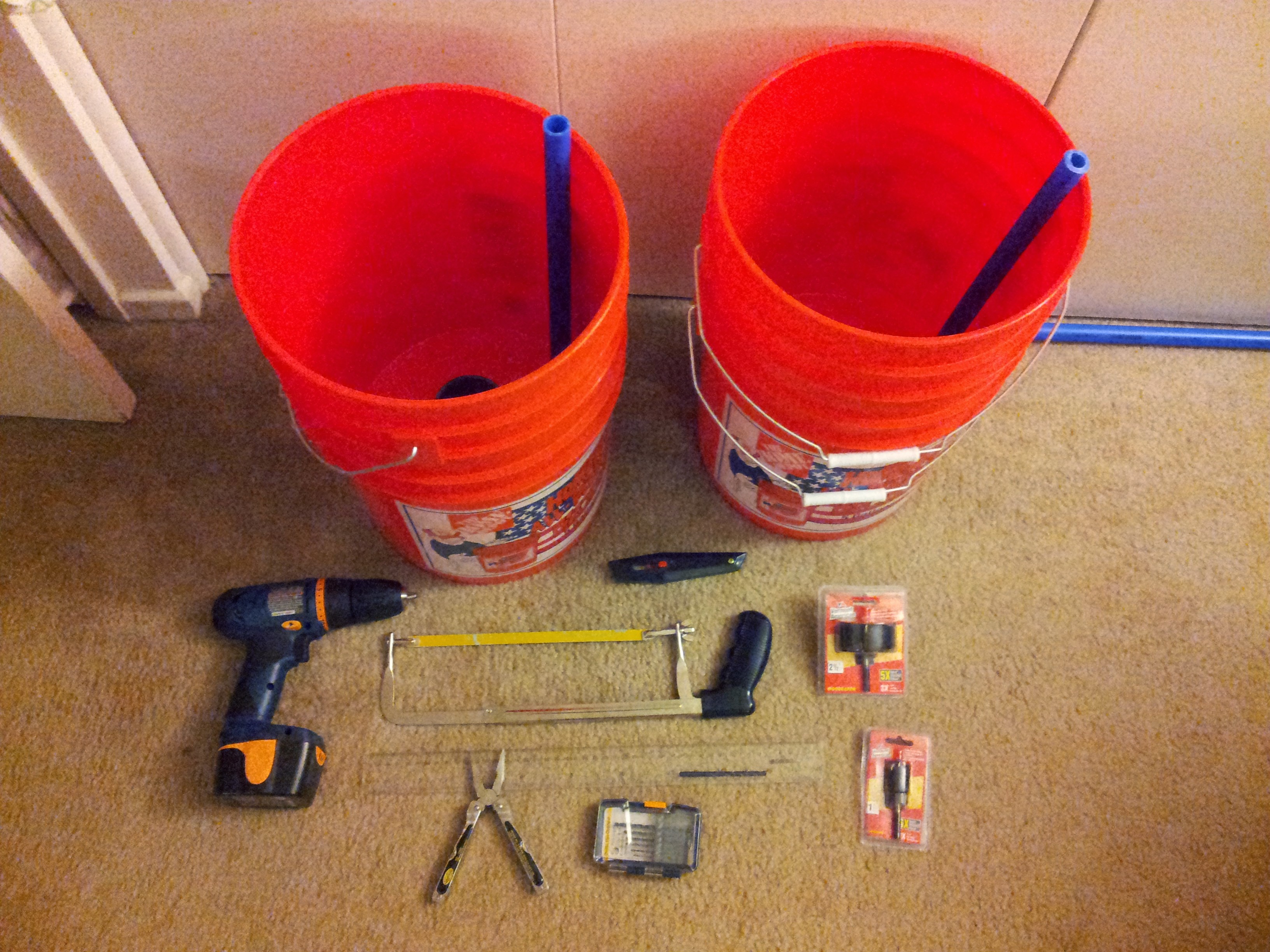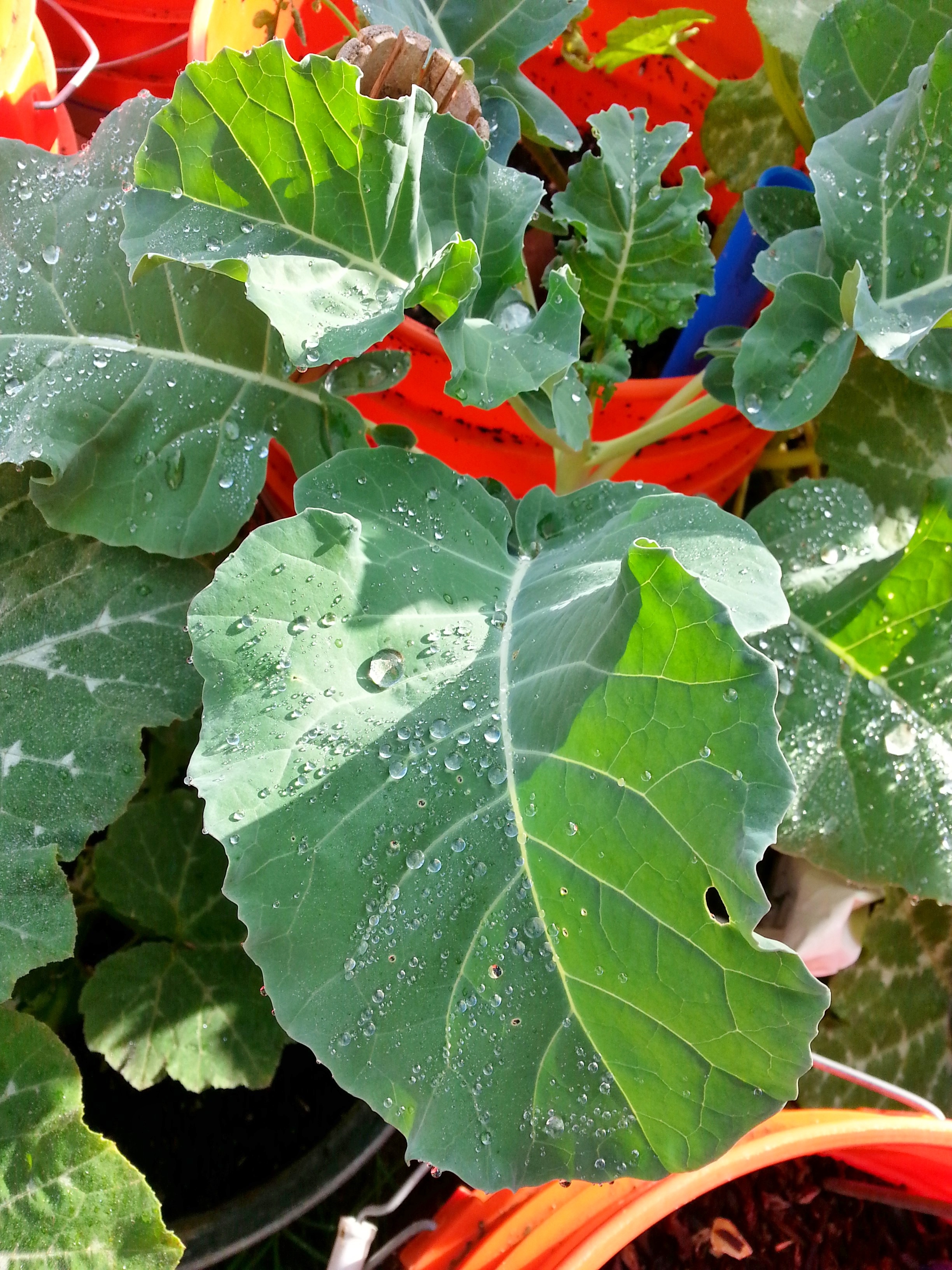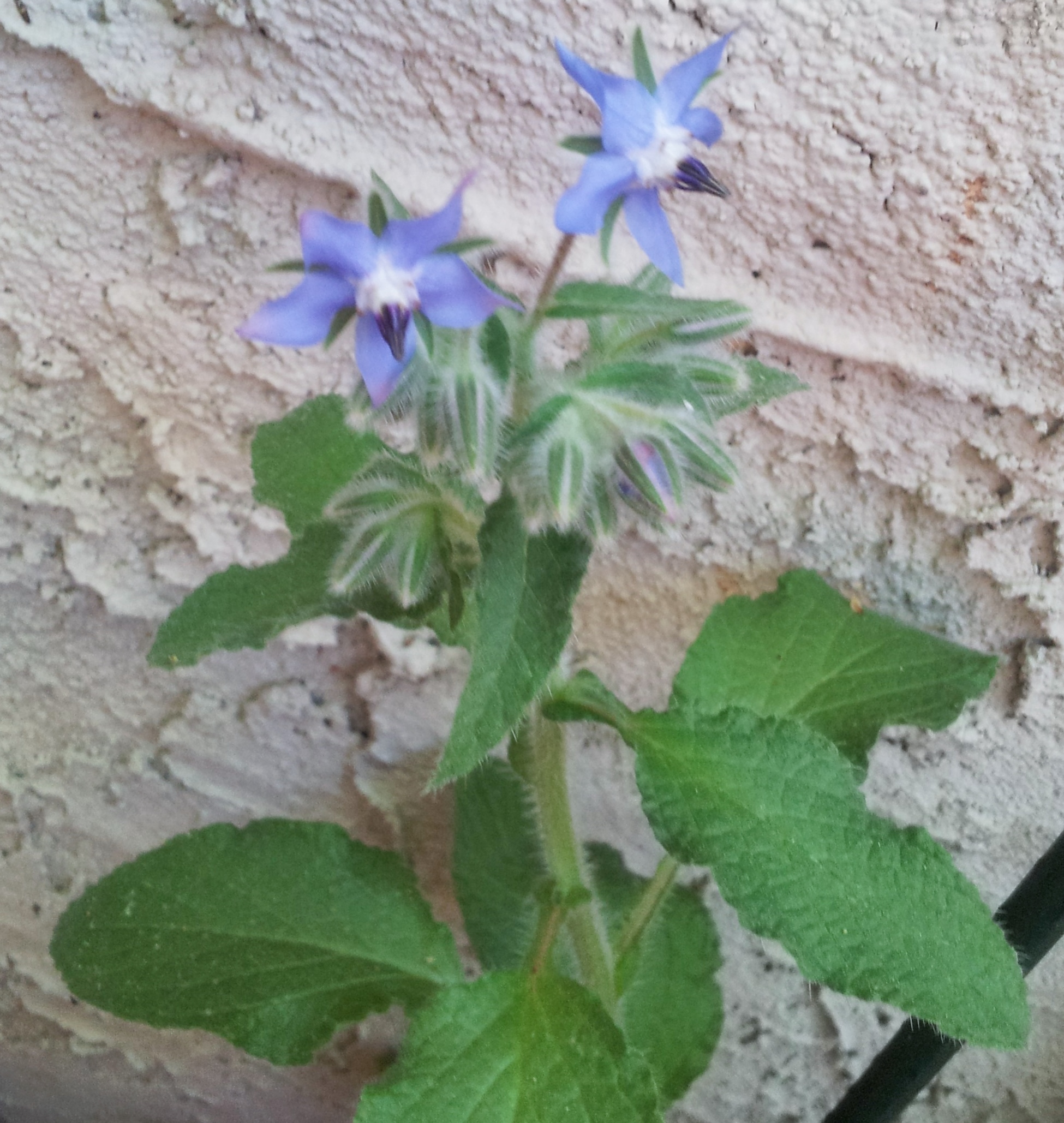 Building a self-watering container garden using 5-gallon bucket containers as we describe throughout this site is a fairly simple process. A single self-watering bucket container, the building instructions for which you can get by clicking here, occupies one square foot of ground or floor space.
Building a self-watering container garden using 5-gallon bucket containers as we describe throughout this site is a fairly simple process. A single self-watering bucket container, the building instructions for which you can get by clicking here, occupies one square foot of ground or floor space.
These brilliant little contraptions conserve water, spare you the labor of constantly watering by hand or running irrigation, protect against pests, create growing space where there otherwise was none, and are entirely portable.
The first thing you need to do is determine how much available space you have and how much light your space gets. In the Northern Hemisphere, a south-facing area is always best, but an east- or west- facing area can be a decent second choice, particularly if it gets at least some southern exposure. In the Southern Hemisphere, a northern exposure is preferred, with east- and west-facing areas being the second choice, particularly if there is at least some northern exposure.
If your plants are being grown for their fruit or roots, they need full sun, but those grown for their leaves or seeds can handle partial shade. Full sun generally means at least six hours of direct sunlight per day, though they don’t necessarily have to be consecutive hours. Consider whether it would be necessary to move some or all of your containers throughout the season (or the day) to follow the sun and, if so, whether you have the time to move them around as much as they need. Consider also if/when the sun is so intense and hot that it may be necessary to shade your plants during at least part of the day.
 If you are a home gardener and do not have adequate space and/or lighting for all the things you want to grow, you may want to consider collaborating with other gardeners in a cooperative gardening arrangement in which you each grow something different in whatever space you each have and share your produce with each other. This can be great for neighbors in buildings with fire escape gardens who only have space for one or two containers out each of their windows, as well as people who have only a small footprint of space that gets adequate light.
If you are a home gardener and do not have adequate space and/or lighting for all the things you want to grow, you may want to consider collaborating with other gardeners in a cooperative gardening arrangement in which you each grow something different in whatever space you each have and share your produce with each other. This can be great for neighbors in buildings with fire escape gardens who only have space for one or two containers out each of their windows, as well as people who have only a small footprint of space that gets adequate light.
If you are a gardening group, such as a classroom of students or a Girl Scout troop, then your options for space may be quite different than the options that exist for people putting in self-watering bucket containers at their homes. Gardening groups may have access to unused lots, paved areas, roof tops, basements (that can be outfitted with grow lights), and other non-typical growing areas that nonetheless provide adequate space and light (or can be outfitted to provide adequate light).
Once you have determined your space and lighting options, you can figure out how many containers your space can support. Remember that you cannot cram every available inch with containers. You need to leave space to walk around and attend to them, including occasionally dragging through a hose, carrying in bags of fertilizer, hauling out freshly picked produce, etc. This means not only walking space, but maneuvering space to squat down, put things down, and rearrange things as needed.
Once you figure out how many containers you can reasonably support, you need to think about what you want to plant in them. For home gardeners, think first of the vegetables you most frequently buy in the store. What fresh vegetables do you already cook in your family and what do you want to add? Research your produce to determine when the best time of year is for each preferred fruit or vegetable to grow. Determine the ideal growing conditions for each type of fruit and/or vegetable you want to grow and how many of each plant you would need to produce a reasonable enough yield.
Certainly location and time of year makes a huge difference for many gardeners. In the United States, you can use the USDA Hardiness Zone Finder, above, to determine which zone you live in, first. Then visit UrbanOrganicGardener.com and scroll down to access its month-by-month planting guide organized by growing zone.
Where possible, grow preferred fruits and vegetables in staggered, overlapping batches throughout their respective growing seasons so that as one batch becomes exhausted, another comes to bear. For vegetables like green beans, once the plants start producing, if you keep picking the beans, they will continue to grow more beans for as long as the weather allows; but, other plants bear their yields all at once and then are done for the season, so staggering them in batches allows for smaller yields coming to bear one after the other over an extended period, which makes things more manageable and keeps you in fresh produce for a longer period of time.
 Consolidate different plants with similar or complementary growing needs in the same containers. You don’t have to segregate your plants by species. Just be careful that you don’t put things that might cross-pollinate with each other too close together unless cross-pollination is what you want. All different types of squash will cross-pollinate with each other, for example, so put your yellow crookneck squash at the opposite side of your operation from your zucchini. Just don’t waste precious growing space inside your containers.
Consolidate different plants with similar or complementary growing needs in the same containers. You don’t have to segregate your plants by species. Just be careful that you don’t put things that might cross-pollinate with each other too close together unless cross-pollination is what you want. All different types of squash will cross-pollinate with each other, for example, so put your yellow crookneck squash at the opposite side of your operation from your zucchini. Just don’t waste precious growing space inside your containers.
Mixing up different species in your containers is called polyculture and impedes the ability of many pests to find what they are looking for (particularly if they are drawn to a particular kind of plant), makes it difficult for plant-specific diseases to spread, and attracts beneficial organisms from the wild. Nature doesn’t grow things in orderly bunches and rows; it mixes things up.
In fact, mixing things up English garden-style by including colorful blooming flowers in your containers, including non-food flowering plants, will help draw pollinators to your garden. The more colorful the blooms your garden contains, the easier it is for pollinators to spot it from the air.
Marigolds (which repel many unwanted insects as well as draw beneficial ones), zinnias, and sunflowers are often used for these purposes, are lovely, and are easy to grow. You may also want to explore including edible flowers, such as borage or pansies, that add nutritional benefits to your diet, draw pollinators to your garden, and make everything look lovely.
 Consider other means of using color to draw pollinators to your garden, such as using buckets that come in any of the same hues as blooming flowers. You can always decorate plain buckets if you want to, which can be a lot of fun!
Consider other means of using color to draw pollinators to your garden, such as using buckets that come in any of the same hues as blooming flowers. You can always decorate plain buckets if you want to, which can be a lot of fun!
Consider starting out lettuce, which can be seeded directly into the soil, and/or several cabbage plants started in seedling pellets in a single container, then eating some of the baby greens as they come in to thin them out until you only have three or four evenly spaced plants left in the container. As they get bigger, you may decide to take some of the baby heads.
Baby bok choy, for example, is actually a type of cabbage and spectacular in stir fries. Picking and eating the baby bok choy as things get crowded will create even more space for the remaining plants to grow to their full size. A single cabbage plant can completely dominate a bucket container, but five bush green bean plants or a fruit-laden tomato plant can fill the same space.
This raises another issue with planning your garden. Devoting months to the better part of a year to grow a single head of cabbage does not satisfy the same food supply needs as five green bean plants that reach maturity rather quickly and will produce beans for as long as you keep picking those that are ready and it’s warm enough outside. This is why we suggest with lettuce, cabbage, and bok choy that you start with multiple plants and eat the baby vegetables as they come up until you’re left with only one that reaches maturity and takes over the container. That way, you at least get more than one meal out of several months worth of waiting.
 Root plants such as beets, carrots, and radishes all grow well in bucket containers. It is easy to mix root plants like carrots and beets with other plants, such as cucumbers and other vining plants that are trained onto trellises. The roots grow down, the vines grow up, and they tend not to get in each other’s way.
Root plants such as beets, carrots, and radishes all grow well in bucket containers. It is easy to mix root plants like carrots and beets with other plants, such as cucumbers and other vining plants that are trained onto trellises. The roots grow down, the vines grow up, and they tend not to get in each other’s way.
The nutritional values of the different types of foods you are looking to grow should also be part of your planning decisions. Legumes, such as red kidney beans, barlotti beans, fava beans, and black beans have high amounts of protein, which is why they are often used with rice as substitutes for meat in vegetarian and vegan cooking. Green vegetables provide nutrients that cannot be obtained from any other food source. Antioxidants can be found in dark berries and edible flowers, such as borage. Yellow and orange carrots provide beta carotene, among other nutrients.
So, your research isn’t just limited to gardening. You also need to investigate nutrition to make sure you understand what each type of fruit and vegetable can give you. The best resource we can give you for this kind of information can be found at the website for Jaime Oliver’s Food Revolution, another non-profit endeavor to educate children about food, healthy eating, and cooking. The Food Revolution’s goal is to combat diet-related diseases, which are the number one killers in the United States at this time, by educating the public – particularly children – about food health and cooking.
For gardening groups made up of classroom students, Scouts, service club members, etc., these nutritional considerations have to be taken into account, but your context may be different. Students building out a classroom garden may have specific instructional goals in mind that influence which plants they grow. Service volunteers building out a garden for a specific group, such as seniors in an assisted living facility, will have to take into account the nutritional requirements and gardening context of the group for/with whom they are building it. So long as you put some thought into what you are doing and make a point to understand how and why non-GMO, organic self-watering container gardens work to provide you with healthy foods, you can grow what you want and need.
